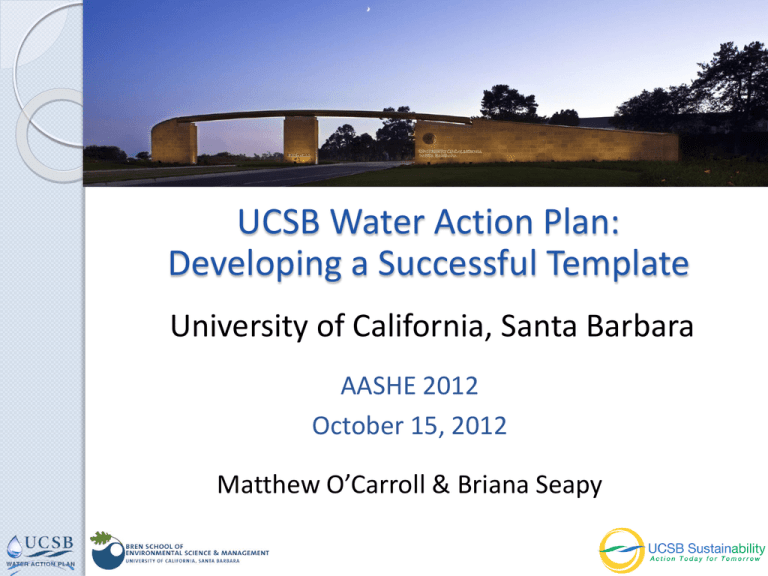Presentation Slides
advertisement

UCSB Water Action Plan: Developing a Successful Template University of California, Santa Barbara AASHE 2012 October 15, 2012 Matthew O’Carroll & Briana Seapy Overview of Talk Water Action Plan (WAP): Motivation Developing a Water Action Plan ◦ Defining Scope ◦ Documentation of Water Use at UCSB Data Collection ◦ Baseline to Benchmark Selection Methodology ◦ Identifying Key Practices & Trends in Water Conservation ◦ Suggesting Future Water Conservation Efforts Making Recommendations Using CBA and CEA ◦ Making Your WAP a Living Successful Document UCSB WAP Template Water Action Plan (WAP): Motivation University of California, Office of the President: Mandate UCSB Future Challenges: Campus growth, Increasing water rates, and Climate change Developing a WAP: Defining Scope Magnitude of UCSB Role in the Region/Local Watershed Geographic Scope of Water Use Temporal Scope Water Scope Developing a WAP: Documentation of Water Use at UCSB Data Collection: Quantitative and qualitative information on UCSB’s water history (utilities statements, interviews, audits) Developing a WAP: Baseline to Benchmark 3-year Baseline (1996/1997-1998/1999) 3-year “Benchmark” (2008/2009-2010/2011) ◦ Purpose: to encourage UCSB to strive for further reductions Baseline to % Benchmark Reduction Total Potable Water 25% Potable Water/ WCU 43% Potable Water/ GSF 52% Developing a WAP: Identifying Key Trends & Practices in Water Conservation Attributing potable water use reduction to past campus actions ◦ Irrigation: Potable to reclaimed ◦ Industrial: Expansion of chilled water loop ◦ Infrastructure Upgrades: Bathroom retrofits Suggesting Future Water Conservation Efforts Cost Benefit Analysis Laying out all the costs and benefits in a way that predicts the economic value of water conservation efforts WAP-G Recommendation using CBA Installation of a RF/NO System to treat waste and storm water for use on landscapes, in toilets, and as water to supplement cooling towers Potential Scenarios: Off-site system at local wastewater facility, centralized facility oncampus, decentralized filtration systems oncampus Collaboration between UCSB, Goleta Sanitary District, Goleta Water District Suggesting Future Water Conservation Efforts Cost Effective Analysis Meeting water savings targets using least cost intensive practices WAP-G Recommendations Bathroom/ shower retrofits Weather-based Irrigation Controllers Matched Precipitation (MP) Rotators Xeriscaping Design Scheduled Maintenance A Living Successful Document Goal Setting ◦ Realistic goals that align with future campus plans (e.g. Long Range Development Plan) Reporting ◦ Annual or Bi-annual basis Collaboration ◦ Sharing ideas and the document itself with stakeholders and other universities UCSB Water Action Plan Template Background/ Introduction ◦ ◦ ◦ ◦ ◦ Overall Importance Regional Context Campus Physical Context Motivation Specific to Campus Definition of Scope (geographic, temporal, water) Campus Water Use Baselines Campus Historical Water Use & Reduction Process Campus Water Use Benchmark Recommendations & Strategies to Achieve Future Water Reduction Goals Financing Opportunities Conclusions & Future Steps Contact Information Email: wateraction@bren.ucsb.edu http://fiesta.bren.ucsb.edu/~wateraction/











